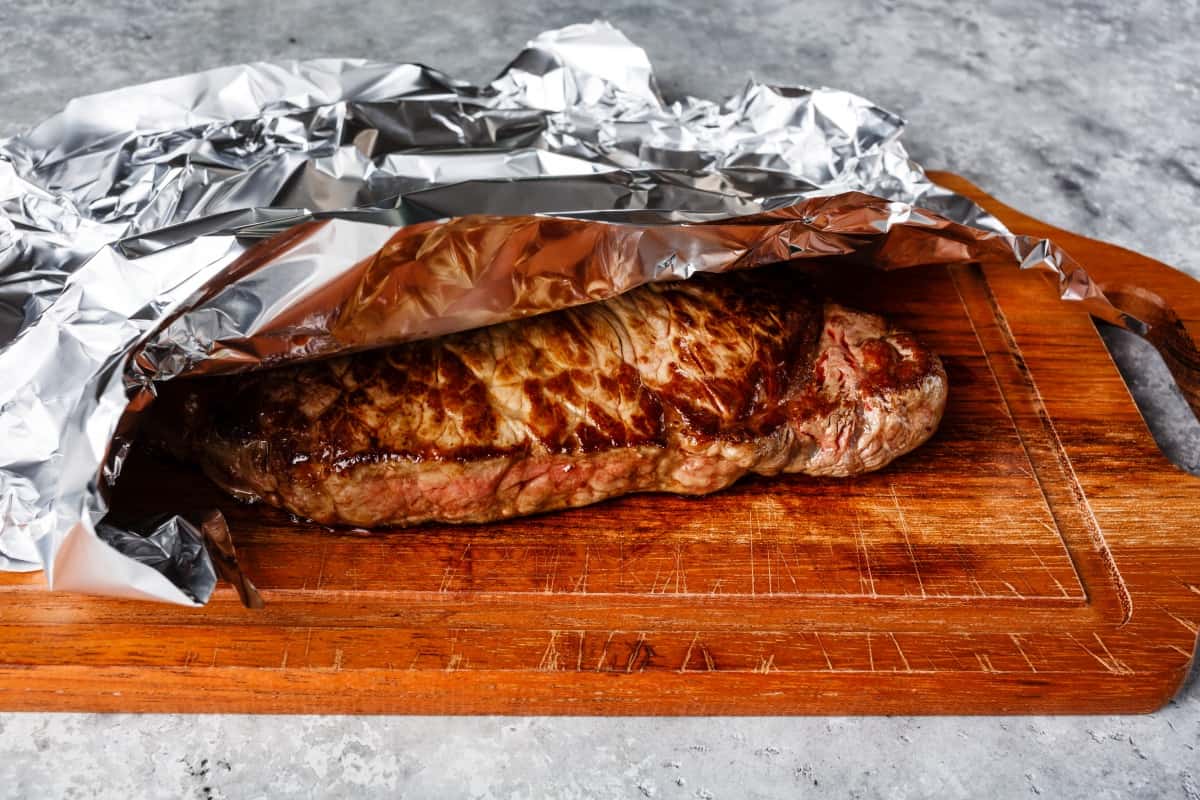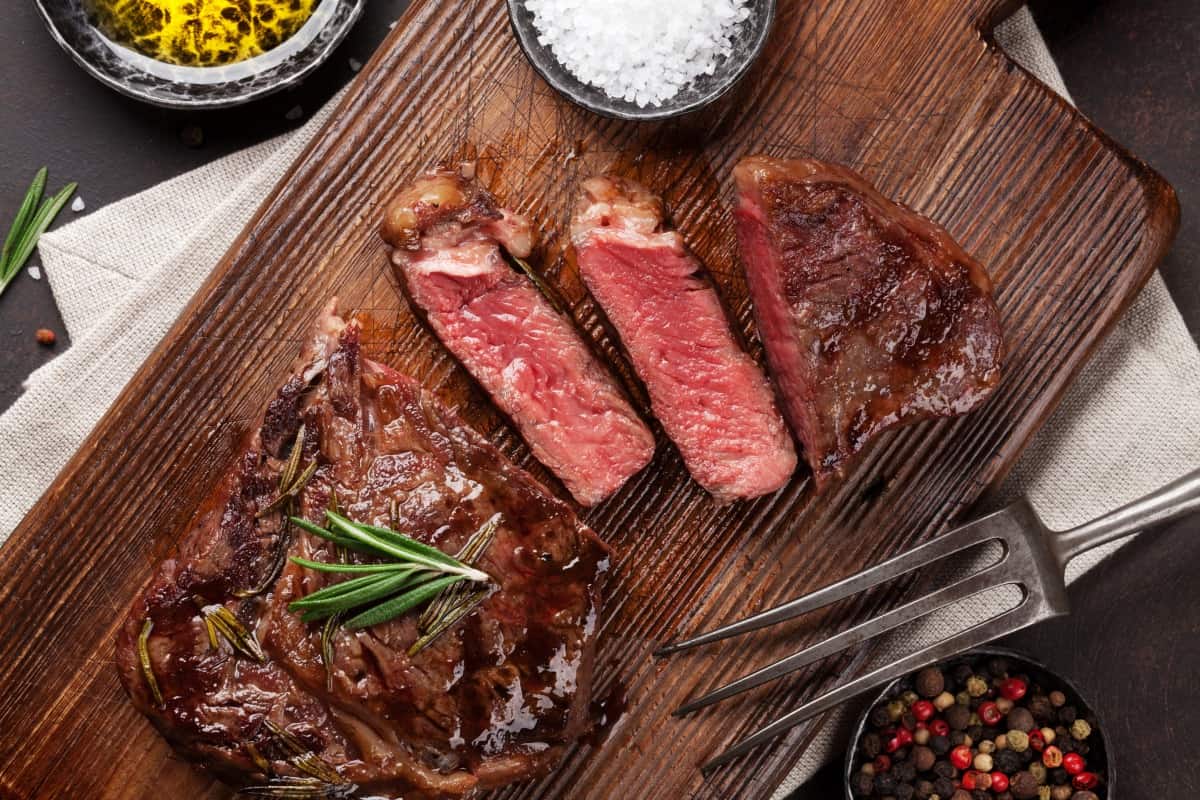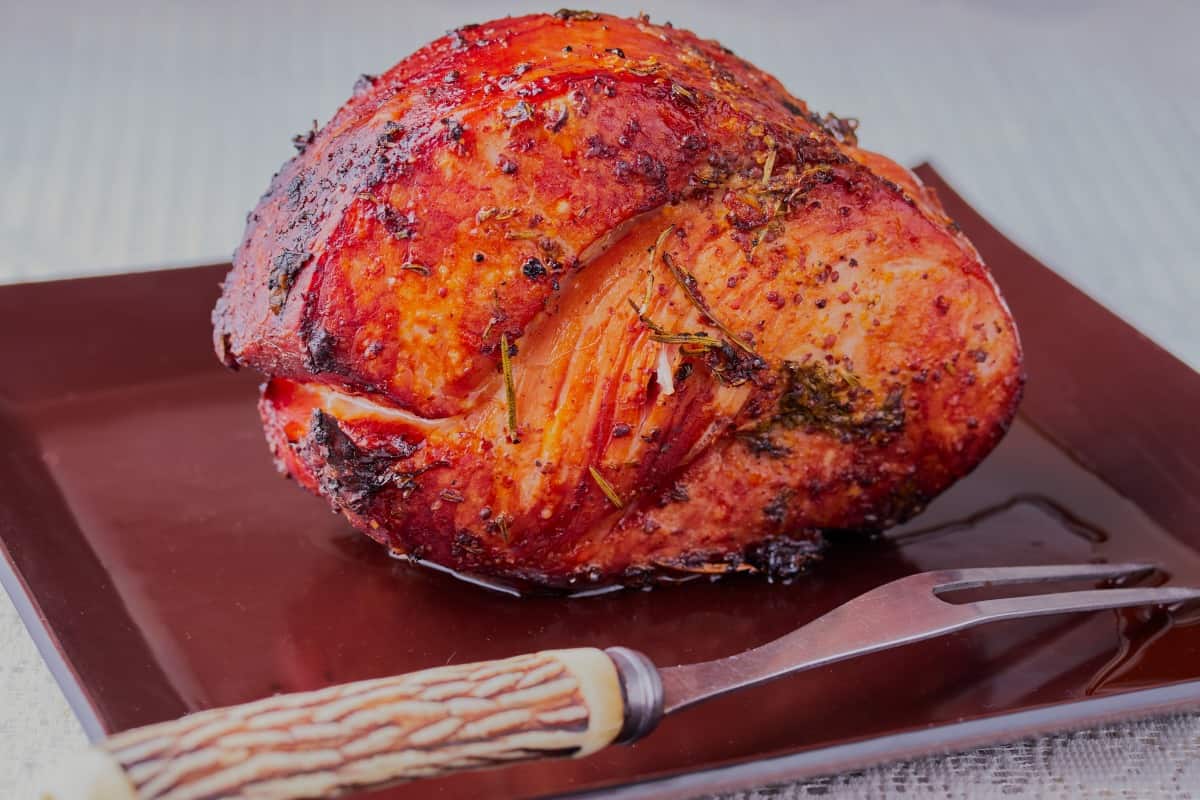How Long to Rest Roast Beef After Roasting for 1 Hour
If yous read almost any recipe or article near cooking any type of steak, chop, or roast; a mutual piece of communication that's given is resting meat earlier you serve, to make it tender and juicy.
You'll be told to residuum steaks for at least 15 minutes, and larger cuts like a brisket, prime number rib or a turkey for half an hour or more than, and you were probably told to tent the meat in foil.
But is it really necessary? What is the benefit of allowing our meat to rest? What is the science behind resting our meat? What volition happen if we cut into it right away? Wouldn't the meat get cold?
These are the questions we answer below.
Contents (Jump to Topic)
- 1 Why Does Meat Need to Residuum?
- 1.one What is the Science Backside Resting Meat?
- two Resting Meat Myth — Why Mayhap We Shouldn't Rest Our Meat
- ii.one What is the Scientific discipline Behind Not Resting Meat?
- 3 What About Large Cuts Of Meat?
- iii.1 Why Would Nosotros Rest a Big Cut Of Meat?
- iii.2 How To Residuum Large Cuts at Home
- 4 What'due south the Final Verdict?
Why Does Meat Need to Residue?

According to James Bristles Accolade Winner J. Kenji López-Alt, the reason to rest meat is elementary: if you cutting into it immediately after cooking, the juices inside run out, leaving you with a tougher and less flavorful piece of meat.
Kenji López-Alt conducted an experiment where he cooked half dozen virtually identical steaks to an internal temp of 125 °F, so removing them from rut and slicing each in half at 2.5-minute intervals and placing the sliced pieces on plates to collect any juices that run out.
The results are shocking, with the steak immediately sliced having a big pool of liquid, while the steak that had rested 10 minutes having well-nigh zero liquid on the plate.
What is the Science Behind Resting Meat?
In his commodity, Kenji López-Alt explained that the mutual conventionalities for resting meat was considering in one case a piece of steak hit a hot pan or grill, the juices inside would be forced towards the center. Past allowing the steak to remainder the juices would accept time to redistribute throughout the steak evenly.
He goes on to explain that it's non that unproblematic.
Meat holding its juices has more to do with the temperature of it than anything else. He compares the fibers in the meat to straws, and the college in temp it is, the tighter the ends of the straws are.
If the muscle fibers are tight, then when the steak is cut the juices will come pouring out. Whereas when the steak is rested and the meat fibers have gone down in temp, the juices in the steak are able to stay inside.
Resting Meat Myth — Why Maybe Nosotros Shouldn't Residuum Our Meat

Craig "Meathead" Goldwyn is a New York Times Bestselling Author and self-proclaimed "Barbecue Whisperer & Hedonism Evangelist." On his website, AmazingRibs.com, he has employed food scientists to help him bust food myths, and he takes exception to the common logic that meat must exist rested.
On his website, he has an entire article defended to why he considers information technology a mistake to residual meat. Throughout the article he gives many good reasons not to residue the meat:
- Over time, the meat will cool. No one wants cold steak!
- Meat will carryover melt, potentially resulting in overcooking
- The fat will brainstorm to solidify and ossify, giving an unpleasant mouthfeel
- The crust created by searing will brainstorm to soften and lose flavour, specially if the meat is tented under tinfoil
- Craven and turkey skin will get from crispy to an unpleasant rubbery texture
What is the Science Behind Not Resting Meat?
Among the squad of people Meathead employs on his website is a science counselor name Dr. Greg Blonder. For his article on resting meat, Dr. Blonder conducted some experiments on both modest and large cuts.
First, he prepared and cooked 2 13.five ounce ribeye steaks using the aforementioned cooking method; he immediately carved ane steak (he cut the steak entirely, not simply one time like Kenji López-Alt) on a cutting board, and rested the second steak 30 minutes before carving.
Using a paper towel he mopped upwards any moisture on the 2 cutting boards and weighed the paper towel on a sensitive scale, after which he subtracted the original weights of the paper towel.
The results?
The steak that was carved immediately had lost 27 grams of liquid, and the rested steak lost 23 grams; a divergence of four grams.
Considering that the steaks were 13.5 ounces in weight to starting time and that four grams is less than 0.15 of an ounce, it certainly seems that the liquid retained due to resting is nigh nil.
What About Large Cuts Of Meat?

So far we've only talked well-nigh steaks. When you compare a 13.v-ounce steak to a large cut like a 14-pound packer brisket, information technology'southward like shooting fish in a barrel to see that the steak is a much smaller cut with not as much liquid to potentially lose as a brisket.
Many of the world's peak barbecue joints agree their meat for two – 3 hours in a Cambro or warm oven, allowing it to stay hot without take a chance of drying out or overcooking it; while too allowing the moisture within to redistribute.
In an interview for NPR'due south "The Salt", Texas A&G Meat Science Professor Jeff Savel stated the post-obit:
"My observation is that this rested barbecue, which could be two to four hours or more than held this way, is the all-time ever produced."
That's a solid vote for keeping your food warm and resting it if you inquire me!
Why Would We Rest a Large Cut Of Meat?
Think Kenji López-Alt and his theory virtually the higher the internal temp of meat is, the easier it is for juice to come out one time information technology is sliced? It turns out he was correct.
Every bit explained by the world's simply total-fourth dimension Barbecue Editor Daniel Vaughn, the internal temperature of a fully cooked brisket is around 200 °F.
While citing author and restaurateur Adam Perry Lang, Vaughn explains that the fat and collagen in brisket turns into gelatin as it cooks, and that gelatin is the primary ingredient in Clot-o. Hot Clot-o is liquid and would run out onto the cut board when sliced, but in one case cooled it will stay inside the slices once cut, keeping them juicy.
How To Rest Large Cuts at Home
The good news for lawn pitmasters is that y'all tin can replicate a Cambro or warming oven at home. Meathead has a cinch method described on his website for how to create what he calls a "faux-Cambro":
- Remove the cooked meat from the grill
- Wrap in aluminum foil (if not already wrapped)
- Wrap in clean towels and place in a make clean, dry cooler
Yous can concur a big pork shoulder or brisket for many hours like this.
There is an additional benefit to resting large cuts of meat; information technology provides flexibility when cooking.
A packer brisket can take anywhere from x to twenty hours to melt at abode, dependent on the size of the joint, the brute information technology came from, fat content and the cooking temperature.
Past assuasive your meat to rest in a faux-Cambro you don't need to worry too much nigh making your guests expect. Y'all can have it off at 1:00pm, balance it in your cooler, and serve at 5:00pm.
What'south the Terminal Verdict?
When it comes to smaller cuts of meat like steak, it'due south credible that in that location isn't much to gain by resting, simply there is much to lose.
If nosotros simply look at the methods used in J. Kenji López-Alt and Dr. Blonder's experiments, there are two important things to consider:
- In Kenji López-Alt's experiment he cuts the meat directly in half, and in Dr. Blonder'due south experiment he cuts it into many strips all at once — neither would likely be done by someone eating a steak.
- In both experiments the steaks that aren't rested are cut immediately later removing from the heat. Again, this would likely not exist done by someone preparing a steak at home.
When I melt a steak at home, it probably takes a good five or half dozen minutes for me to bring the steaks within, get them onto individual plates, get the sides ready, prepare the table, pour a glass of wine, phone call the kids to eat, etc. Then when I cutting into my steak, I don't cut directly into the middle, I start on one end and work my fashion beyond. I'1000 betting y'all practice these sorts of things likewise.
The point I'1000 trying to make, is that even though I didn't add an extra step of deliberately resting my meat, my steak has had some time to rest. Also, I'm not going to cut information technology into 20 pieces allowing a lot of juice to run out, and the longer it takes to eat my steak, the longer it is going to rest.
When information technology comes to larger cuts, it does appear that resting meat tin can be very beneficial. Large roasts and cuts like brisket and pork shoulder tin can stay hot for hours in a "imitation-Cambro", while allowing the juices inside to redistribute evenly.
What do y'all think? Practise you unremarkably residual your meat at home, or do you lot simply simply serve it when it'southward ready?
Please practice let u.s.a. know in the comments below your thoughts on resting and why? What you typically do, and if you'll be making any changes subsequently reading this article.
Source: https://www.foodfirefriends.com/resting-meat/
0 Response to "How Long to Rest Roast Beef After Roasting for 1 Hour"
Post a Comment